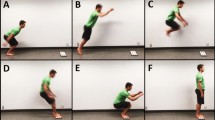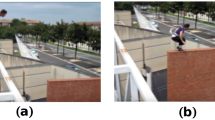Abstract
Explosive movements such as throwing, kicking, and jumping are characterized by high velocity and short movement time. Due to the fact that latencies of neural feedback loops are long in comparison to movement times, correction of deviations cannot be achieved on the basis of neural feedback. In other words, the control signals must be largely preprogrammed. Furthermore, in many explosive movements the skeletal system is mechanically analogous to an inverted pendulum; in such a system, disturbances tend to be amplified as time proceeds. It is difficult to understand how an inverted-pendulum-like system can be controlled on the basis of some form of open loop control (albeit during a finite period of time only). To investigate if actuator properties, specifically the force-length-velocity relationship of muscle, reduce the control problem associated with explosive movement tasks such as human vertical jumping, a direct dynamics modeling and simulation approach was adopted. In order to identify the role of muscle properties, two types of open loop control signals were applied: STIM(t), representing the stimulation of muscles, and MOM(t), representing net joint moments. In case of STIM control, muscle properties influence the joint moments exerted on the skeleton; in case of MOM control, these moments are directly prescribed. By applying perturbations and comparing the deviations from a reference movement for both types of control, the reduction of the effect of disturbances due to muscle properties was calculated. It was found that the system is very sensitive to perturbations in case of MOM control; the sensitivity to perturbations is markedly less in case of STIM control. It was concluded that muscle properties constitute a peripheral feedback system that has the advantage of zero time delay. This feedback system reduces the effect of perturbations during human vertical jumping to such a degree that when perturbations are not too large, the task may be performed successfully without any adaptation of the muscle stimulation pattern.
Similar content being viewed by others

References
Bizzi E, Hogan N, Mussa-Ivaldi FA, Giszter S (1992) Does the nervous system use equilibrium point control to guide single and multiple joint movements? Behav Brain Sci 15:603–614
Bobbert MF, Huijing PA, Ingen Schenau GJ van (1986a) A model of the human triceps surae muscle-tendon complex applied to jumping. J Biomech 19:887–898
Bobbert MF, Huijing PA, Ingen Schenau GJ van (1986b) An estimation of power output and work done by the human triceps surae muscle-tendon complex in jumping. J Biomech 19:899–906
Bootsma RJ, Wieringen PCW van (1990) Timing an attacking forehand drive in table tennis. J Exp Psychol [Hum Percept] 16:21–29
Bullock D, Grossberg W (1991) Adaptive neural networks for control of movement trajectories invariant under speed and force rescaling. Hum Movement Sci 10:3–53
Ebashi S, Endo M (1968) Calcium ion and muscle contraction. Prog Biophys Mol Biol 18:125–183
Ettema GJC, Huijing PA (1989) Properties of tendinous structures and series elastic components of EDL muscle tendon complex of the rat. J Biomech 22:1209–1215
Feldman AG (1986) Once more on the equilibrium point hypothesis (lambda model) for motor control. J Motor Behavior 18:17–54
Gordon AM, Huxley AF, Julian FJ (1966) The variation of isometric tension with sarcomere length in vertebrate muscle fibres. J Physiol (Lond) 184:170–192
Gottlieb GL, Agarwal GC (1979) Response to sudden torques about ankle in man: myotatic reflex. J Neurophysiol 42:91–106
Grieve DW, Pheasant S, Cavanagh PR (1978) Prediction of gastrocnemius length from knee and ankle joint posture. In: Asmussen E, Jorgensen K (eds) Biomechanics VI-A. University Park Press, Baltimore, pp 405–412
Grillner S (1981) Control of locomotion in bipeds, tetrapods and fish. In: Brooks VB (ed) Handbook of physiology, sect 1, The nervous system, vol 2, Motor control. Williams and Wilkins, Baltimore, pp1179–1236
Hatze H (1981) Myocybernetic control models of skeletal muscle. University of South Africa, Pretoria
Hill AV (1938) The heat of shortening and the dynamic constants of muscle. Proc Royal Soc 126B:136–195
Hogan N, Bizzi E, Mussa-Ivaldi FA, Flash T (1987) Controlling multi-joint motor behavior. Exerc Sport Sci Rev 15:153–190
Katz B (1939) The relation between force and speed in muscular contraction. J Physiol (Lond) 96:45–64
McMahon TA (1984) Muscles, reflexes and locomotion. Princeton University Press, Princeton, NJ, pp 148–161
Petrofsky JS, Phillips CA (1980) The influence of temperature, initial length and electrical activity on the force-velocity relationship of the medial gastrocnemius muscle of the cat. J Biomech 14:297–306
Reiss M, Taylor JG (1991) Storing temporal sequences. Neural Networks 4:773–787
Schmidt RA (1982) Motor control and learning: a behavioral emphasis. Human Kinetics, Champaign, IL
Shampine LF, Gordon MK (1975) Computer solution of ordinary differential equations. The initial value problem. Freeman, San Francisco
Soest AJ van, Schwab AL, Bobbert MF, Ingen Schenau GJ van (1992) SPACAR: a software subroutine package for simulation of the behavior of biomechanical systems. J Biomech 25:1219–1226
Soest AJ van, Schwab AL, Bobbert MF, Ingen Schenau GJ van (1993a) The influence of the biarticularity of the gastrocnemius muscle on vertical jumping achievement. J Biomech 26:1–8
Stern JT (1974) Computer modelling of gross muscle dynamics. J Biomech 7:411–428
Taga G, Yamaguchi Y, Shimizu H (1991) Self-organized control of bipedal locomotion by neural oscillators in unpredictable environment. Biol Cybern 65:147–159
Visser JJ, Hoogkamer JE, Bobbert MF, Huijing PA (1990) Length and moment arm of human leg muscles as a function of knee and hip joint angles. Eur J Appl Physiol 61:453–460
Vos EJ, Mullender MG, Ingen Schenau GJ van (1990) Electromechanical delay in vastus lateralis muscle during isometric contractions. Eur J Appl Physiol 60:467–471
Wadman WJ, Denier van der Gon JJ, Geuze RH, Mol CR (1979) Control of fast goal-directed arm movements. J Hum Movement Stud 5:3–7
Werff K van der (1977) Kinematic and dynamic analysis of mechanisms, finite element approach. Ph. D. thesis, Delft University of Technology, Delft, The Netherlands
Winters JM (1990) Hill-based muscle models: a systems engineering perspective. In: Winters JM, Woo SL-Y (eds) Multiple muscle systems. Biomechanics and movement organization. Springer, Berlin Heidelberg New York, pp 69–93
Author information
Authors and Affiliations
Rights and permissions
About this article
Cite this article
van Soest, A.J., Bobbert, M.F. The contribution of muscle properties in the control of explosive movements. Biol. Cybern. 69, 195–204 (1993). https://doi.org/10.1007/BF00198959
Received:
Accepted:
Issue Date:
DOI: https://doi.org/10.1007/BF00198959



